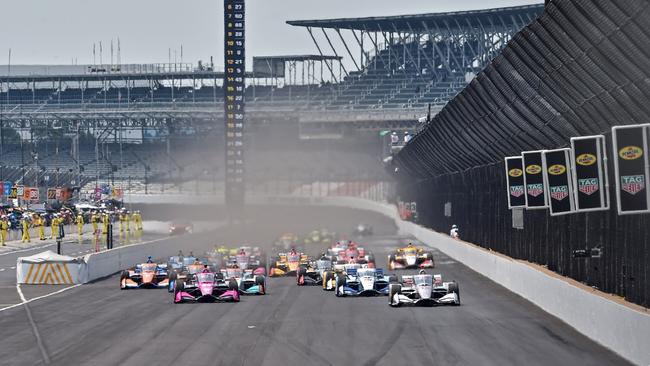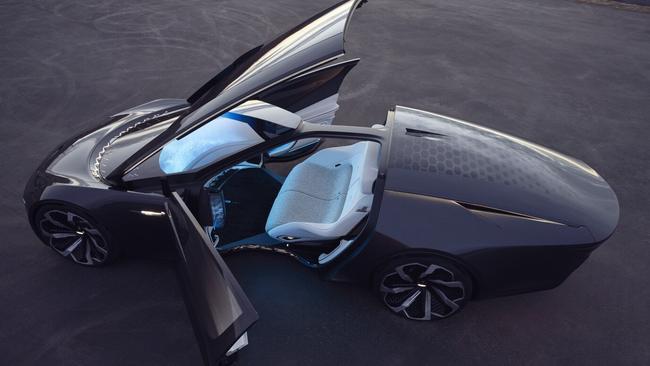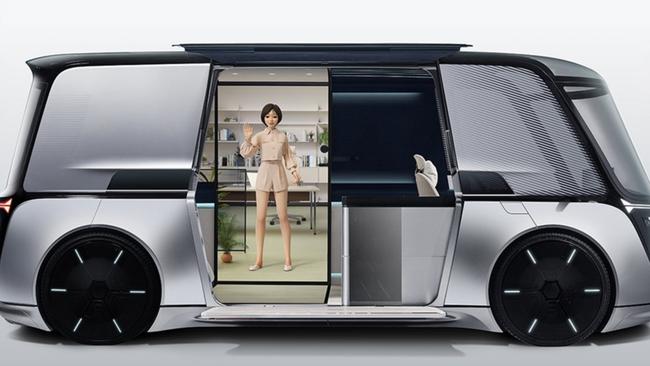Self-driving cars are getting smarter, safer in traffic and will start arriving in Australia in 2022
Australian companies are at the forefront of making self-driving cars a reality. See what they have developed and what’s coming.
Weaving through Tokyo streets with no driver, screeching around race tracks with no one inside, and replacing seats with beds and dashboards with screens — self-driving cars are promising a transport revolution.
And that is in addition to augmented reality windscreens, virtual in-car concierges, and options to add autonomous driving to existing cars with cameras and a subscription.
While the technology might seem ripped from science fiction, experts say self-driving cars are becoming more practical, with options coming to market this year.
And they argue Australian roads and regulations will not only be ready for these futuristic vehicles but Australian innovation will power many of their features.

News Corp investigated this emerging technology as part of a six-part series on our tech-fuelled future, The Future of Everything, that will look at innovations from flying cars to business meetings using holograms.
Autonomous vehicles first captured the attention of Australians a decade ago, iMove Cooperative Research Centre managing director Ian Christensen said, and inspired self-driving experiments across Australia.
Autonomous and connected cars have since driven through every state and territory, in trials including a 3000km journey through regional Victoria, a trial of 350 connected cars in Queensland, and self-driving shuttle buses in New South Wales, South Australia, Tasmania and Western Australia.
Mr Christensen said the public’s reaction to driverless buses had been overwhelming.
“Most of the responses have been, ‘can’t they go a bit faster?’ The community is now pushing for better performance which is a good mindset to bring to the introduction of autonomous vehicles,” he said.
But ensuring self-driving cars are as safe — if not safer — than human drivers has been a harder task than many researchers and companies expected.
Despite huge investments, no company has mastered level five autonomy in which human drivers are no longer required to touch the steering wheel.
Efforts to test the technology in the US have shown huge potential but one by Uber also resulted in the death of a pedestrian.
“Self-driving vehicles can operate but how do you make sure that they operate in 100 per cent of situations; that they respond to kids kicking footballs or don’t get confused between a wombat and a log?” Mr Christensen asked.
“That’s a hard task and that’s delayed their wider rollout.”
Companies are making further breakthroughs, though. Intel’s automated driving firm MobileEye revealed at January’s Consumer Electronics Show that its technology allowed self-driving cars to navigate busy Tokyo streets and drive on German roads with no lane markings — a problem that had plagued the industry.
South Australian firm Cohda Wireless has also been tapped to take part in a German autonomous car trial, while Canberra-based Seeing Machines has started recruiting families to test ‘seat occupancy detection’ technology.
QUT’s Centre for Robotics also signed a two-year, $271,000 deal with Ford to investigate how to improve self-driving car cameras and LIDAR to recognise their environment.
Project leader, Professor Michael Milford, said Australian technology was likely to play a vital role in the development of self-driving cars and the country would be quick to adopt them despite a slow start.
“Australia was very behind the pack maybe five or six years ago on an international scale,” he said.
“In those five or six years, we’ve done a lot of trials and investigations into whether Australians are ready to use the technology. Now all the key players — the government, infrastructure providers and the general public — are so much better informed, and leading Australian R & D firms are getting more involved in autonomous vehicles.”
The technology would still require huge investments from the world’s biggest firms, like Google, Apple, Tesla and major car makers, Prof Milford said, but if they were able to crack it, self-driving cars could emerge within five years. There’s still little indication of how much the technology would cost for buyers, though.
“You will see a decision point in the next two to five years where this technology starts to make tangible commercial sense or there’s a pullback,” he said.
“Personally, I’d love to be able to take a nap on the way home or on the way to the beach.”
FIVE TOP SELF-DRIVING CAR PROJECTS
Volvo: Would you pay a subscription for your car to drive itself? That’s the question to be posed by Volvo, which revealed some of its next-generation vehicles could be used with a service called Ride Pilot in future. The service will debut in California first, after it’s approved, and will use 24 sensors and LIDAR to “see” the road ahead.
Cadillac: What will cars look like when humans don’t have to drive them any more? According to Cadillac, they’ll be impossibly sleek, futuristic sports cars with interiors that looks like the first class cabin of a plane. The company revealed its InnerSpace concept this year, showing off a car with two reclining seats that pivot outwards when the doors open upwards, and a giant LED screen for entertainment.

Samsung: The smartphone maker recently showed off its concept for a smart car windscreen that would show information like 3D maps, information about nearby shops, pedestrian crossings, and even road signs obscured by tall vehicles ahead. In self-driving mode, it could connect them to video conferences. No word on when the augmented reality concept could become reality.
LG: Unveiled at the 2022 Consumer Electronics Show, LG’s vision for self-driving cars might be one for the distant future. The LG Vision Omnipod looks like a family van outside but inside it features modular furnishings that can be moved around to create a mobile gym, workspace, sleep pod, or entertaining space, with a digital concierge in a screen on the wall.

Race cars: Staged on the Las Vegas Motor Speedway with nine cars, nine teams but no drivers, the Indy Autonomous Challenge was designed to prove what autonomous vehicles could do. The race, started by a flag-waving robotic dog, saw cars hit speeds of 278km/h and was claimed by the Polimove team from Italy and the US.
>> The Future of Everything will continue next Friday, revealing what happened to the promise of flying taxis
More Coverage
Originally published as Self-driving cars are getting smarter, safer in traffic and will start arriving in Australia in 2022





